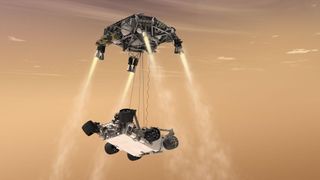How a Future Mars Lander Could 'Crush It' on the Surface

Landing on Mars is a tricky business. A thin atmosphere, a far-away planet, and heavier spacecraft today all combine to make it difficult to make it to the surface. Over the years, only a fraction of the missions that tried to land on Mars made it to the surface. Just ask the European Schiaparelli team who lost their lander in the last few minutes of descent in 2016.
While the Schiaparelli failure was not due to problems with the landing system, the European Space Agency, as well as other teams, are always looking at ways to simplify the complicated landing process. Instead of traditional landing legs or airbags, they propose a crushable lander that could be made of something like an aluminum honeycomb core, with a polyethylene cover sheet.
"The crushable platform design will be used for all small lander missions with high impact velocity," Silvio Schroeder, who is with the German Aerospace Center, said in an e-mail. A crushable lander might be used in PhoDEx, a proposed mission to Phobos, one of two moons orbiting Mars. The ESA has not yet committed to the mission, but it is under consideration.
A similar design was proposed for the Schiaparelli lander, but the lander did not make it to the surface as planned and crashed. A crushable lander called MASCOT (Mobile Asteroid Surface Scout) is also flying to asteroid Ryugu aboard the mission Hayabusa-2, where it will be tested after the mission arrives in 2018.
RELATED: Mars Lander Crashed, Possibly Exploded
For the newer version of the design, the researchers tested its properties in a lab to see how well it performed under different conditions.
So far, 12 drop tests have been performed with a simulated spacecraft, including different vertical and horizontal velocities, and touchdowns with inclinations of 10 degrees. The tests were recorded with high-speed cameras, and measurements, such as for impact depth, were also collected.
Get the Space.com Newsletter
Breaking space news, the latest updates on rocket launches, skywatching events and more!
Additionally, the researchers ran numerical simulations to provide touchdown predictions, and also to validate the results they saw in the lab. For the most part, the lab tests and the simulations agreed, the researchers noted.
"Both the simulation and the experimental testing have proven the system design of a stable lander concept without landing legs," the researchers wrote. "The test setup could deliver the lander to the designated touchdown point at the right velocity."
They added, "No critical lander damages appeared during all tests of the diverse scenarios. Although no stability tests (prevention of toppling over) have been performed, the platform showed a stable behavior in every situation. The surface platform showed flexion under the load of impact, which needs to be studied in more detail."

Schroeder said future tests will seek to improve the crash performance by "use of other materials and inner structure", but he needs to keep the details vague due to potential future patents for the technology.
The next European mission to Mars will be the ExoMars rover landing, albeit with a more traditional system. The rover will launch in 2020 and a landing site has not yet been selected. It's expected that the rover's Russian landing platform will use aerobraking, which involves skimming the Martian atmosphere, parachutes, and thrusters to make it to the surface.
Some successful Mars mission landings — after deploying a parachute to slow down — have included retro-engines, used with NASA Viking landings of the 1970s, as well as Pathfinder, Spirit, and Opportunity rovers in the 1990s and 2000s, and a "crane" system, used by Curiosity rover in 2012, which used engines during the descent stage to slow the rover down, then lower it to the surface.
Originally published on Seeker.
Join our Space Forums to keep talking space on the latest missions, night sky and more! And if you have a news tip, correction or comment, let us know at: community@space.com.

Elizabeth Howell (she/her), Ph.D., is a staff writer in the spaceflight channel since 2022 covering diversity, education and gaming as well. She was contributing writer for Space.com for 10 years before joining full-time. Elizabeth's reporting includes multiple exclusives with the White House and Office of the Vice-President of the United States, an exclusive conversation with aspiring space tourist (and NSYNC bassist) Lance Bass, speaking several times with the International Space Station, witnessing five human spaceflight launches on two continents, flying parabolic, working inside a spacesuit, and participating in a simulated Mars mission. Her latest book, "Why Am I Taller?", is co-written with astronaut Dave Williams. Elizabeth holds a Ph.D. and M.Sc. in Space Studies from the University of North Dakota, a Bachelor of Journalism from Canada's Carleton University and a Bachelor of History from Canada's Athabasca University. Elizabeth is also a post-secondary instructor in communications and science at several institutions since 2015; her experience includes developing and teaching an astronomy course at Canada's Algonquin College (with Indigenous content as well) to more than 1,000 students since 2020. Elizabeth first got interested in space after watching the movie Apollo 13 in 1996, and still wants to be an astronaut someday. Mastodon: https://qoto.org/@howellspace
Most Popular


